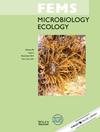Cynanchum auriculatum Royle ex Wight 的叶屑导致茄科镰刀菌爆发根腐病,妨碍连作
IF 3.5
3区 生物学
Q2 MICROBIOLOGY
引用次数: 0
摘要
由于土壤传播的真菌病原体,Cynanchum auriculatum Royle ex Wight(CA)在连作障碍(CCO)方面遇到了挑战。在根部收获后,CA 的落叶会定期融入土壤,但这种做法对病原体爆发的影响仍不确定。在这项研究中,分离出了一种真菌菌株 D1,经鉴定为 Fusarium solani,并证实它是导致 CCO 的潜在因素。研究发现,叶提取物(LE)和根提取物(RE)都能抑制种子萌发和植物防御相关酶的活性。提取物和 D1 的组合加剧了这些负面影响。除了促进 D1 在土壤中的增殖外,萃取物还提高了 D1 的菌丝重量、孢子数量和孢子萌发率。与 RE 相比,LE 对 D1 的致病相关酶的活性有更大程度的促进作用。此外,咖啡酸和阿魏酸也被确定为潜在的活性化合物。LE,特别是与 D1 结合使用时,诱导真菌群落而不是细菌群落的组成发生变化。这些发现表明,枯落叶水提取物刺激了真菌菌株 D1 的生长和增殖,从而增强了其对 CA 的致病性,并最终促进了 CCO 过程。本文章由计算机程序翻译,如有差异,请以英文原文为准。
Leaf litter from Cynanchum auriculatum Royle ex Wight leads to root rot outbreaks by Fusarium solani, hindering continuous cropping
Cynanchum auriculatum Royle ex Wight (CA) is experiencing challenges with continuous cropping obstacle (CCO) due to soil-borne fungal pathogens. The leaf litter from CA is regularly incorporated into the soil after root harvesting, but the impact of this practice on pathogen outbreaks remains uncertain. In this study, a fungal strain D1, identified as Fusarium solani, was isolated and confirmed as a potential factor in CCO. Both leave extract (LE) and root extract (RE) were found to inhibit seed germination and the activities of plant defense-related enzymes. The combinations of extracts and D1 exacerbated these negative effects. Beyond promoting the proliferation of D1 in soil, the extracts also enhanced the hypha weight, spore number, and spore germination rate of D1. Compared to RE, LE exhibited a greater degree of promotion in the activities of pathogenesis-related enzymes in D1. Additionally, caffeic acid and ferulic acid were identified as potential active compounds. LE, particularly in combination with D1, induced a shift in the composition of fungal communities rather than bacterial communities. These findings indicate that the water extract of leaf litter stimulated the growth and proliferation of fungal strain D1, thereby augmenting its pathogenicity towards CA and ultimately contributing to the CCO process.
求助全文
通过发布文献求助,成功后即可免费获取论文全文。
去求助
来源期刊

FEMS microbiology ecology
生物-微生物学
CiteScore
7.50
自引率
2.40%
发文量
132
审稿时长
3 months
期刊介绍:
FEMS Microbiology Ecology aims to ensure efficient publication of high-quality papers that are original and provide a significant contribution to the understanding of microbial ecology. The journal contains Research Articles and MiniReviews on fundamental aspects of the ecology of microorganisms in natural soil, aquatic and atmospheric habitats, including extreme environments, and in artificial or managed environments. Research papers on pure cultures and in the areas of plant pathology and medical, food or veterinary microbiology will be published where they provide valuable generic information on microbial ecology. Papers can deal with culturable and non-culturable forms of any type of microorganism: bacteria, archaea, filamentous fungi, yeasts, protozoa, cyanobacteria, algae or viruses. In addition, the journal will publish Perspectives, Current Opinion and Controversy Articles, Commentaries and Letters to the Editor on topical issues in microbial ecology.
- Application of ecological theory to microbial ecology
- Interactions and signalling between microorganisms and with plants and animals
- Interactions between microorganisms and their physicochemical enviornment
- Microbial aspects of biogeochemical cycles and processes
- Microbial community ecology
- Phylogenetic and functional diversity of microbial communities
- Evolutionary biology of microorganisms
 求助内容:
求助内容: 应助结果提醒方式:
应助结果提醒方式:


